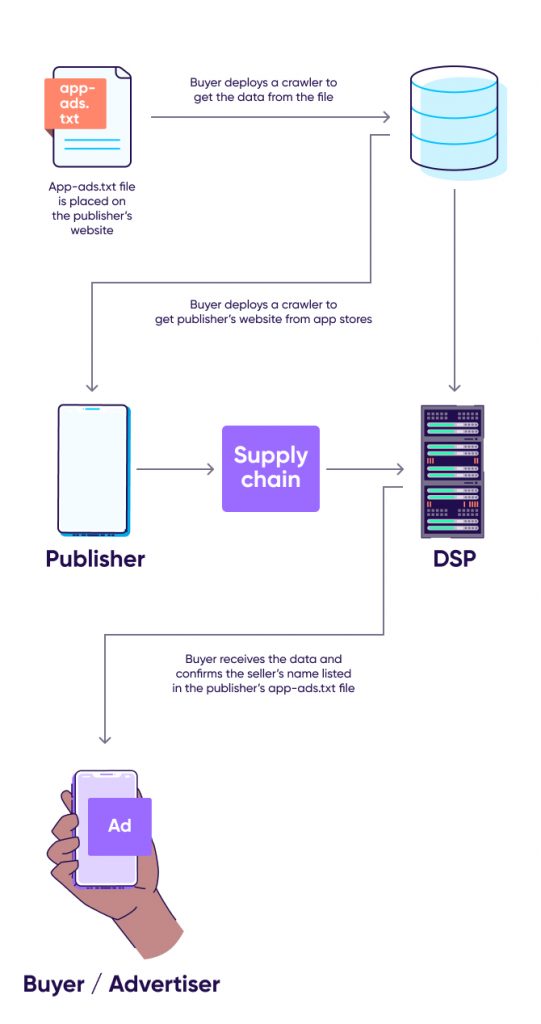
App-ads.txt

A text file app developers/publishers add to their developer website to list vendors authorized to sell their inventory, app-ads.txt helps the participating players to overcome various limitations of programmatic advertising, including the lack of transparency and security.
What is app-ads.txt?
Formally known as Authorized Digital Sellers for Mobile Apps, App-ads.txt is a tool for app developers and publishers to authorize specific ad networks and supply-side platforms (SSPs) to sell their inventory.
In essence, it’s a text file that lists legitimate ad tech vendors who have permission to sell the publisher’s digital ad inventory.
Publishers can upload the app-ads.txt to their developer website on the one hand, and on the other, developers can crawl the developer website and evaluate the app-ads.txt file. That, in turn, will help them accept bid requests from ad networks and SSPs listed in the file.
In an effort to improve transparency between buyers and sellers in programmatic advertising, the Interactive Advertising Bureau (IAB) Tech Lab announced the release of app-ads.txt in November 2018, which was also an extension of the ads.txt file to the mobile in-app advertising and OTT advertising world.
Because it offers a wide array of benefits for both publishers and advertisers, various established app stores, including Google Play and the Apple App Store, support the use of app-ads.txt.
How does app-ads.txt work?
Mobile app developers upload the app-ads.txt file to their developer website. Alternatively, they can use online app-ads.txt hosting platforms to upload it for them. They then include the developer website URL in every app store listing.
Buyers/advertisers can crawl individual app stores to identify the developer website for a particular app. Once they retrieve the URL, advertisers can crawl the developer website to identify vendors authorized to sell the publisher’s ad inventory, which comes in handy when they need to decide whether to accept or reject bid requests from an ad network or SSP.

Top 4 benefits of app-ads.txt
The purpose of app-ads.txt is to prevent unauthorized sales of in-app ad inventory, offering several benefits for both advertisers and publishers.
1 – Improved security

The most significant benefit of app-ads.txt is that it helps curb the menace of ad fraud. While programmatic advertising is efficient and quick, it minimizes direct communication between buyers, sellers, and ad tech vendors. Bad actors use that as an opportunity to sell unauthorized inventory and fake impressions.
The most common problems associated with digital advertising include:
- Unauthorized reselling – Third-party resellers sell ad inventory without any information about the seller. It results in underpriced inventory and causes a loss of revenue for publishers.
- Counterfeit inventory – Fraudulent ad tech vendors mislead buyers by claiming access to the inventory they aren’t authorized to sell. That, in turn, leads advertisers to accept bid requests for fake inventory.
- Domain spoofing – Bad actors, such as fraudulent ad networks or SSPs, impersonate a legitimate publisher’s app and claim to sell their inventory. It steals revenue from sellers while misleading advertisers to spend on forged inventory.
App-ads.txt helps minimize the risk of the problems mentioned above. It ensures that advertisers only accept bid requests from authorized and legitimate ad tech vendors with access to the desired inventory in a publisher’s app, and makes the programmatic advertising ecosystem more secure.
Additionally, app-ads.txt ensures that publishers don’t lose their precious revenue to underpriced inventory and domain spoofing. Instead, they have complete control over who gets to sell or resell their inventory.
2 – Enhanced transparency and trust
With app-ads.txt, advertisers can verify the claims of an ad tech vendor. They can visit the publisher’s developer website and find out whether a vendor has access to their inventory, which makes the process of ad buying and bidding more transparent.
Moreover, modern advertisers consider app-ads.txt as a mark of credibility and reliability. So, providing the file on their developer website will help publishers earn advertisers’ trust.
3 – Guaranteed brand safety
The use of app-ads.txt ensures that an advertiser’s campaigns run on legitimate and relevant ads. It protects their brand image and maximizes their chances of reaching their target audience at the right time.
On the other hand, publishers can rest assured knowing that bad actors can’t plagiarize their apps, nor can vendors claim to have access to their inventory without prior authorization. It helps publishers reinforce their reputation and trustworthiness.
4 – Amplified revenue
Proper implementation of app-ads.txt eliminates the need for publishers to worry about losing revenue to plagiarized apps or forged inventory. Instead, they can get their hands on every dollar an advertiser spends on their inventory.
Similarly, app-ads.txt minimizes the risk of advertisers falling into the trap of deceitful ad tech vendors, as it reduces the risk of losing precious advertising dollars due to fake impressions and clicks. Ultimately, it improves the performance of their campaigns and helps them achieve a higher return on ad spend (RoAS).
App-ads.txt example
The app-ads.txt file comprises various lines for different ad networks and SSPs. Each app-ads.txt record includes the following elements:
- Ad system domain
- Publisher account ID
- Account type/relationship
- Certificate authority ID
Here’s what an actual app-ads.txt record looks like:
Google.com, pub-00000000000000000000, DIRECT, f08c47fec0942fa0
Let’s explore each element of app-ads.txt records in detail:
Ad system domain
The canonical domain name of the advertising system (or ad network) the buyer will use to access the publisher’s inventory. If, for example, a publisher wants to authorize Google’s ad network to sell their inventory, they can use “Google.com” as the ad system domain.
Publisher account ID
A unique identifier associated with the publisher’s account or reseller account in the advertising system. “pub-00000000000000000000” is the publisher account ID in the example above.
Account type/relationship
Here, “DIRECT” indicates that Google’s ad network will directly offer the publisher’s inventory to interested buyers, and denotes the type of relationship the seller shares with the vendor. The publisher can list a vendor as “direct” or “reseller,” depending on whether the vendor uses third-party resellers for selling inventory.
Note: Publishers shouldn’t add any vendor to their app-ads.txt file until they or their partners have a connection with them.
Certificate authority ID
A unique ID that identifies the advertising system (or ad network) within a certification authority. “f08c47fec0942fa0” is the certificate authority ID in the example above.
App-ads.txt implementation

App-ads.txt is an easy-to-use and straightforward tool. However, its implementation needs to be executed well to provide advertisers and publishers with maximal benefits.
For instance, registering a domain name and hosting the developer website is a prerequisite to implementing the file. Similarly, developers/publishers must watch out for errors in naming the .txt file.
Here’s an overview of the steps involved in app-ads.txt implementation:
- The developer provides their website URL in every app store listing.
- The publisher reaches out to different vendors (ad networks and SSPs) and asks for their app-ads.txt record in the following format: ad system domain, publisher ID, account type/relationship, certificate authority ID.
- The publisher uses Notepad or another text editor to create a file listing individual app-ads.txt records received from different vendors. Each record is typically entered in a new line. They save the file with the name “app-ads.txt.”
- The developer uploads the file in their root domain (the URL would look something like this: “https://example.com/app-ads.txt”)
Publishers can refer to the IAB guidelines to learn more about creating and implementing app-ads.txt.
Key Takeaways
- App-ads.txt is a simple tool developed by the IAB to prevent ad fraud and improve transparency in programmatic advertising. It extends the benefits of ads.txt to the mobile in-app and OTT advertising ecosystems.
- It comprises a list of ad networks and SSPs who are authorized to sell a publisher’s app inventory. The file is available on the corresponding developer website, and advertisers can use it to determine whether they should accept or reject bid requests from a vendor.
- Implementing app-ads.txt well provides the following benefits:
- Improved transparency and trust
- Reduced risk of counterfeit inventory and domain spoofing
- Minimal loss of advertising revenue due to unauthorized reselling
- Higher ROI for advertisers
- Guaranteed brand safety
- As a publisher/developer, it’s crucial to ensure that each record is in the correct format. Doing this well can help both publishers and advertisers reap the maximum benefits of programmatic advertising.



